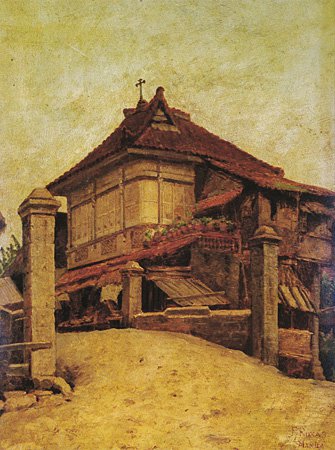Cultural Center of the Philippines
ENCYCLOPEDIA OF
PHILIPPINE ART
Puente de Paete
(Paete Bridge) aka A House by a Bridge in Paete / 1885 / Oil on cardboard / 53.3 x 40.6 cm / Artist: Felipe Roxas / Luis Ma. Araneta collection
This is one of four extant works by the artist who in the 19th century was known for his paintings of buildings, like churches and private homes, in various styles. The work captures a view of a street in Paete, Laguna, actually showing a small bridge spanning the mountain stream that transects the town.
The painting affirms Roxas’s distinction as a consummate realist. What evidently drew him to paint the scene was not just the bridge but also the imposing colonial-style house standing on the opposite side of the bridge. Each of the two entrances of the bridge was highlighted by brick posts, one on each side. Three of these posts could be seen in the painting. The bridge span partly covers the foundation and first floor of the house. It is the backside of the house that faces this side of the street, as could be gathered from the appearance of the corner of the upper floor nearest to the viewer, which is usually neglected for being the kitchen area. A rear azotea whose balustrade is decorated with flower pots can also be seen.
Roxas painstakingly painted the important details of a middle-class house. The walls of the main part of the house feature iron-grill balustrades and sliding capiz windows. Four colonettes rising up to the overhanging eaves provide variety to the texture of the lattice shutters. The gabled roof, covered with red tiles, has an attic window. The rising posts of the bridge and the vertical shape of the house as well as that of the painting itself mark the removed elegance of the place. The rich textural variety suggested by bricks, tiles, and wood is expediently evoked by Roxas’s rugged brushwork. The vibrant impasto and solid modeling of shapes give evidence of his training at the Academia de Bellas Artes.
Roxas submitted this piece to the Exposicion Nacional de Bellas Artes de Madrid in 1892, when he had already permanently left Manila, having migrated to Paris where he died.
Written by Santiago A. Pilar
